Area residents split over ways to address deer overpopulation, culling methods

Courtesy of Brian Underwood
Syracuse and Town of DeWitt officials are considering different ways to address local deer overpopulation amid concerns of Lyme disease transmission.
Syracuse and DeWitt residents are split over ways to address deer overpopulation in the local area.
Culling plans to curb the local deer population come after years of lobbying from an Urban Deer Task Force spearheaded by Brian Underwood, an associate professor at the State University of New York College of Environmental Science and Forestry. Culling generally means shooting and killing deer.
One main concern of deer overpopulation is that it’s tied to an increase in people contracting Lyme disease. Onondaga County has witnessed the largest increase of cases of tick-borne illnesses, in comparison to other areas of central New York. More than 500 of these cases were reported from 2008 to 2015 in the county, compared to only 75 cases from 2000 to 2007, according to CNYcentral.com.
New York state Assemblywoman Pamela Hunter (D-Syracuse) said this number has grown “exponentially” because nothing has been done to curb the deer population since 2013, when the study was originally conducted.
“We have not received the kind of communication that we feel necessary relative to the risks related to Lyme disease,” Hunter said. “(Lyme disease) is definitely underreported, sometimes undiagnosed, so it affects people in many ways across our community.”
Other deer overpopulation concerns include property damage, automobile accidents and incidents with household pets, according to an Urban Deer Task Force report.
Christine Manchester, sustainability coordinator for the Town of DeWitt and a member of the Urban Deer Task Force, said the overpopulation debate is “very contentious.”
“I think that everybody on the initial task force walked away frustrated,” Manchester said. “It’s a very controversial issue, and it’s often led with emotion instead of science, (so) if you’re on one far end or the other, it’s really hard to get to a point where everybody is happy.”
This tension is reflected by opposing opinions throughout Syracuse and DeWitt.
Linda DeStefano, the co-founder and president of People for Animal Rights of CNY, said she’s skeptical about the motives of local residents who want to kill deer.
“People are mostly concerned about (damage to) their gardens,” she said. “They have mostly spoken about Lyme disease because it might be a little bit embarrassing to say, ‘Let’s kill a large number of deer in order to protect my tulips.’”
DeStefano said there are other ways of dealing with Lyme disease, including a study conducted by the Cary Institute of Ecosystem Studies. That study focused on nonlethal de-infection of white-footed mice, the main carriers of a bacterium that can cause ticks to carry Lyme, she said.
The task force ultimately found culling was the most effective way to tame the deer population because of the unprecedented density of deer in the two areas, Manchester said.
Paul Curtis, a wildlife specialist at Cornell University and contributor to the task force, said culling is both the quickest and most cost-efficient way to curb the deer population in an urban area where hunting is prohibited. He added that the task force reviewed all other options related to curbing the deer population.
Still, many feel their ideas were overshadowed by assumptions about how to deal with deer overpopulation.
“I feel our voice has not been heard at any level. At the town level, the village level, the county level or the state level,” DeStefano said. “There just seems to be this very simple-minded incorrect idea of ‘deer numbers equal more Lyme disease and the only way you’re going to deal with that is (through) killing.’”




